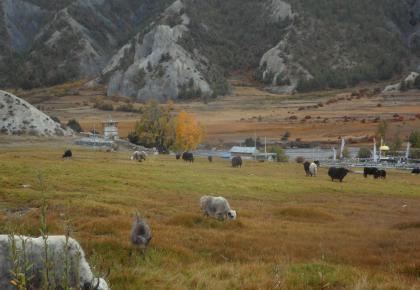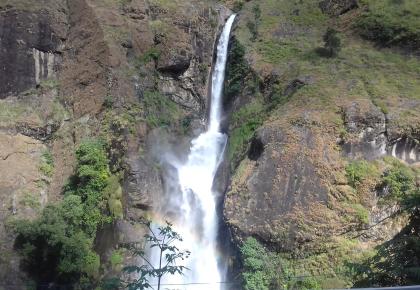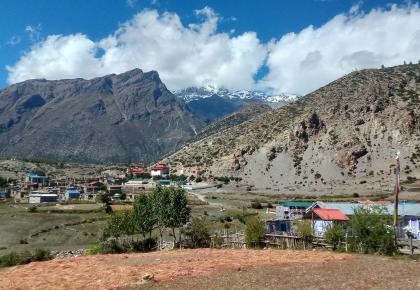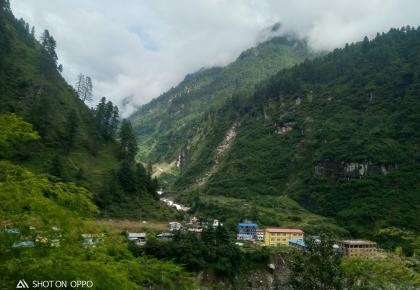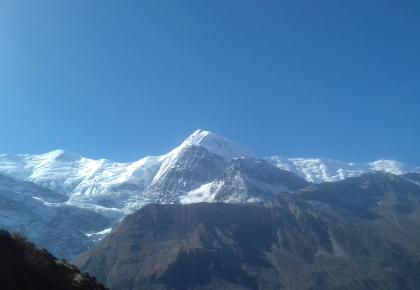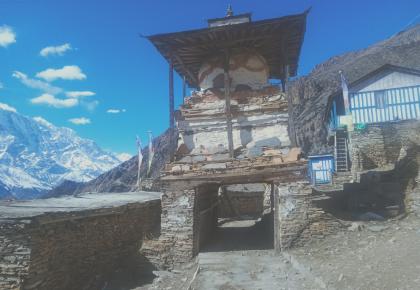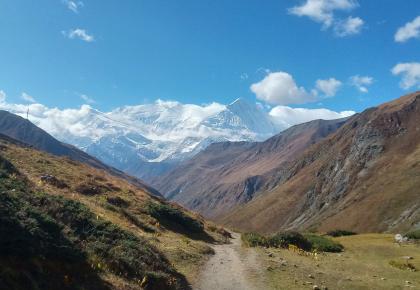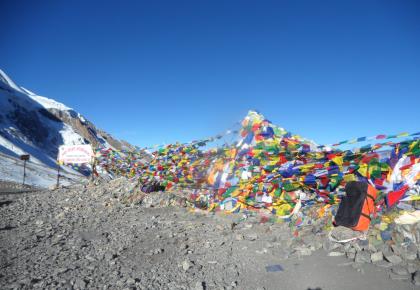Nar Phu Valley Trek
-
16 Days
Duration
-
5,240 m
Max Altitude
-
Moderate
Trip Grade
-
2-14
Group Size
-
SEP-DEC & March-May
Best Season
Trip Highlight
- Oppertunities to involve the respected mix Gurung and Magar lifestyles.
- Observe the lower land People’s culture and Customs.
- Surrounded by charming Valley of Nar and Phu villager.
- Impressive hike through the natural river sound of Marsyandi river.
- Observe the Gurung and Tibetan cultures.
- Glances of the picturesque mountains views from Kang La pass.
- Lovely Mt.Annapuran, Gangapurna, Tilicho, Kangsar Mountains views from Gyaru village.
- Unforable hike with breath-taking mountains view in Kang La pass.
- Vivid Gangapuran glacier near Manag.
- Involve the buddhist Villagers i Nar Phu village.
- Sightseeing in traditional village Kagbeni and Jhong village.
- Experiences the hike into the Marsyangdi river with views of Mountains.
- Accupy tibetan styles's kingdom of Upper pisang and Nawal.
- Observe the Tibetan lifes styles in high up Manag and Kaligandki Valley.
- Expereinxe the lawer land locals peoples cultures.
Trip Overview
Located on the north of Annapurna, the valley of Nar & Phu have remained virtually lost in the lap of Himalayas for centuries until 2002 when it was opened for trekkers all over the world to explore this ancient world. The Buddhist culture and belief systems are still sublime in this region. The majority are the herders of yak; so it makes sense that yak husbandry is what they have been doing for so long.
The Narphu valley trek hits the beginning from Syange. For a while, the trail is same as of Annapurna Circuit but soon it diverges from Dharapani. Along the trail, you come across several waterfalls, Chortens, and canyons, but the scene becomes wilder when all the usual green scene becomes overlapped by the dryness of Nar and Phu valley. People there are amazing. Although they don’t share English, their smile and welcoming nature are enough to have an interesting conversation. Tibetan culture is still alive in the hearts of these people. For more detailed information what you see along the trek, please go through the detailed itinerary section. Such a region is hard to find. So, hurry up to pack your bags and leave your eyes astonished in the Himalayan grandeur of Nepal.
Overview Itinerary
Day 1: Arrival-Pick up from Nepal airport and transfer to your hotel
Day 2: Trek preparation and some sight seen in KTM valley
Day 3: Kathmandu to syage (1050M) –Drive -8-9 hours
Day 4: Syage to Darapani (1150M)-6-7 hours
Day 5: Darapani to Koto (2630M)-6 hours
Day 6: Koto to Meta (3540 M)-7-8 hours
Day 7: Meta to Phu gaun (4260M)-7hours
Day 8: Phu gaun-acclimatization day
Day 9: Phu gaun to Nar (4220 M)-6 hours
Day 10: Nar-Acclimatization day
Day 11: Nar to Kang La pass (5320M) to Nawal (3640M)-7-8 hours
Day 12: Nawal to Chame( 2630M)
Day 13: Chame to Tal (1930M)
Day 14: Tal to Jagat to Beshisaher
Day 15: Beshisaher to KTM
Day 16: Departure-fly back to your home.
Day to Day Itinerary
Peeking through the window of the airplane is one of the best ways to relish the beauty of Nepal. As you arrive at the Tribhuvan International Airport in Kathmandu, one of our airport representatives will greet you and escort you towards your hotel.
If you have time then, you may go to see Kathmandu Durbar Square, which is not too far from Thamel area. You may purchase trekking gears in the market of Thamel (if applicable).
Kathmandu is lavished with arts and architectures. With 7 architectural marvels listed in UNESCO World Heritage Sites within the valley, this city is simply amazing to wander around. On this day, you will go to visit some of the sites that are incredible in its own way: Pashupatinath Temple (Golden Statue), Swayambhunath Temple (vantage point of Kathmandu valley), Boudhanath Stupa (massive mandala), and Patan Durbar Square (ancient royal palace of Malla Kings). These structures are admired by thousands of spectators. Now, it is your turn.
Drive from Kathmandu to Syange follows a scenic route via Besisahar, which is the starting point for most of the trekking in Annapurnas. Probably, this is from where the road starts to get dusty and bumpy. As you drive ahead from Besisahar along the gushing river of Marshyangdi underneath the road, your body sways along the windy trail and sometimes up and down: occasionally hitting your head up on the roof of vehicle. But good news is that the scene of lush green hills looks so enticing that the pain on the vehicle fades away. Or even if it doesn’t, stick to one slogan “No pain, no gain.”
Syange to Dharapani is considered to be the most beautiful walk in the Annapurnas. The trail tracks your way sometimes up and sometimes down along the fair rugged trail parallel to the lush scenery around. As you leave Syange, you will cross a bridge. There is the place where the wider lane for jeeps and walking path merge.
After a steep climb from syange, you come to Jagat, which is one of the stations for trekkers trekking in Annapurna Circuit. But you will keep moving until you reach Dharapani via a beautiful village named Tal (literally translates to Lake).
Today, you make a head start towards a beautiful village of Bagarchhap embracing the pine and fir forests throughout the trail. Soon you would see the lush valleys turning colorful and vibrant if you are travelling in the monsoon. From somewhere in the middle of the trek, you will have a glimpse of Mt. Manaslu and subsequently after walking a while, Mt. Annapurna-II stands shining with the sunlight. Continuing with few ascends and descends along the Danaque and Timang, the trail pokes few waterfalls amidst green cliffs that is beautiful to stumble across. Soon after, you will come to a beautiful village of Koto where you spend your night.
You will hit the road as soon as the sun lights up above the high mountains or perhaps before that as there is a long way to go today. Crossing the river along the trail, you will enter the majestic valley of Nar & Phu. Here is when the real adventure begins.
Contrary to the sophistication in Annapurnas, this region is not quite developed because of its less exposure to modern world. But that makes this valley unique to others. You will pass through beautiful forests, cave shelters, and waterfalls emerging from a grand canyon while on the way to Meta. As you gain the altitude the air gets thinner and the forests get sparse, but the scene grows more vivid and lively. After a long walk of about 8 hours, you come to Meta for the stay.
Once you leave Meta, the colorful Chortens begin to appear in sight inkling the beauty what Phu has to offer at the end of the day. Crossing a suspension bridge hanging over a stream, you would see no houses, but remnants of the ones left by Khampas (Tibetan refugees who illegally settled in this region). Blue sheep dazzle your eyes time and again along the rocky trail to Phu.
As you step into the sphere of Phu world (the lost valley for the centuries), a new beauty charges the milieu. A line of chortens coloring the landscape and beautiful Tashi Lhakhang Gompa (one of the biggest monasteries in the world) comes into view. This monastery was built by Karmapa Rinpoche who came to Nepal with Dalai Lama in late 1950s.
Because of the high altitude, it is better to acclimatize in the valley of Phu. Also, you will have a chance to explore the lives of villagers in greater complexity and depth: what they eat for meals and how do they prepare ingredients.
To paint a picture in mind, Phu is a small rural settlement, where the total population of the village is less than 500. They highly depend on yak husbandry. Narrow alleys take you to different regions of the Phu valley. For an extra exertion, you may hike up to the Himlung himal.
Today’s trail wants you to retrace your steps back up to the Nar phedi monastery and diverge your way towards a village of Nar. Some trekkers also stop-over at Nar phedi in the monastery, which is the only place to stay overnight there. But you forward our steps towards another hidden world (Nar).
Following the windy trail, you come across several colorful chortens along the rugged pave way. Soon after a while, you will get yourself lost in the beauty of Nar, which in itself was lost for many years. You will stay overnight in one of the lodges in the Nar.
Nar is certainly a best place to explore around. Unlike what you saw in Phu, Nar valley is quite lively and full of people. People are dressed in like a perfect Himalayans. Women are found weaving clothes and blankets. Every kid is happy to share a smile and Namaste at least without expectation of any financial reward. Recently, new tea houses are being built. This village is perfect to experience the ancient lifestyle.
It is going to be a long walk today so, hitting the trail earlier than the sun wakes up would be a best option. Long walk certainly doesn’t infer to difficulty as crossing the Kang la pass is easy. But the altitude may be a problem. More you sour up on to the top, the air gets thinner and thinner and every steps feels like a running in Marathon. As you beat the highest point of this trek (5320 m), Annapurna II, Gangapurna, and Tilicho Peak come into view. Everything looks incredible from the top. To be typical, it is heavenly there.
Then, you descend towards Ngawal. The more you fall, the more you feel good to go. As you reach Ngawal, the environment feels completely different. Adorned with modern amenities such as wifi, and extended menus in the hotels, this place feels like time travelling from ancient world to modern earth.
As you descend to Chame, the trail grows broader and broader, and forest area starts fattening up. At first few stops, you will be able to witness the gorgeous Annapurna and Chortens standing stiff and colorful on the way. At times, gorges appear with a beautiful stream flowing amidst the rocky cliffs. But that slowly disappears when you come close to Chame. Crossing Ghyaru, Pisang and Bhratang, you will arrive at your destination, where you stay for the night.
As you come to Chame, the trail becomes quite better. You go through few settlements to mark your destination to Tal.
From Tal, you will hit the road to Besisahar via Jagat. If you wish, you can take a drive because this is the same route you went through to embark on a journey to the Nar Phu valley.
Besisahar to Kathmandu is the same route you followed on the third day. It shows the end of the trek and again coming to the bustling capital.
After a long trek, it is time to get back home and share your memories in blogs and with friends and families. Say goodbye to all the amazing people, culture and mountains until you revisit Nepal.
Includes:
- International and domestic airport transfers on private jeep or bus.
- 3 Night Accommodation in 3 stars hotel with breakfast in Kathmandu.
- Twin-sharing/double bed room in guest house during the trek.
- Private jeep to trek starting point and from trek ending point to Kathmandu.
- English speaking, experienced trekking guide- Trained by Nepal government.
- Required trekking permits (Annapurna conservation area fee and TIMS card)
- Porters (2 clients get 1 porter) to carry clients backpack during the trek.
- Farwell dinner in Kathmandu before your departure.
- Duffle bag (only for trek) and free T-short for clients.
Excludes:
- Your international flight tickets fare.
- Nepal visa (you can apply Nepal visa at Tribhuvan international airport easily)
- Lunch and dinner in Kathmandu.
- Beverages such as cold drinks, alcohol drinks.
- Traver insurance to cover the risk and emergency evacuation.
- Your Personal trekking gear and equipment.
- Personal expenses which are not included in package.
- Tips for guide and porters.
FAQ's
Well experienced local guides and proper mountain porters and well management are main rules to make our customers satisfied. Experiences of the two decades in tourism sector managing their trekking plan and others activities properly to make their ’s dream to bring into the reality according to our customer’s interest, time and trekking areas. We focus on suitable, comfortable and safety plans for our valuable guests to experiences doing mainly trekking, climbing and any tours without ant obstacles. Our team always focus on to provides services to meet our guests ‘s targets, destination and aims in the remote areas of the Himalaya with open heart.
We are easy going local company to manage every single plan for our guests according to their interest. What we say is” GUEST IS GOD”. We value the guests first in our business. What we have is experienced staffs to manage every single thing easily in proper way. Well experienced field staff such as Guides and helpers/porters are the main back bone to stand among you to provides best services. “COME AS A GUEST GO AS A FRIEND”.
We spent more than two decades supporting to the local people in remote area of Nepal. We always provide proper local guides for the proper trekking area/routes. All guides are trained by Nepal government with some training of the First aids. All field staffs are selected sincerely to make sure you are in right in high mountains. Friendly Nepal team is coordinating to peoples who are scattering on the all over the world. I hope our two-decade working experiences in mountains and management in tourism sector may help you to explore the Nepal with confident with right people!!!
We can rent or hire, most of the trekking gear in Kathmandu/Nepal such as a four-season sleeping bag, Puffy down jackets, Micro pikes, trekking shoes, and others. we help you to hire or rent all required trekking gear before your trekking.
Hired trekking gears are must to keep safely if rented gears found damaged then you need to pay the same coast of the gear. You should keep certain amount of money to rent trekking gears. Normally, Trekking gears shop keep deposit $ 100 USD for a sleeping bag and a Puffy down jacket. Renting charge per day is approx. USD 1.50.
One of the re-presentative from Friendly Nepal treks come with private bus or car to pick you up from Tribhuvan airport and drop you in your guest house. With your details of the international flight and your full name, they will be standing in front of the arrival gate in Nepal airport.
Easily you can recognize the staff from Friendly Nepal treks with their T-Short and your name in holding bord. we always make you sure you are in right destination.
Tourists easily can apply their Nepali Visa upon the arrival in Tribhuvan Airport. It may take a few 30 minutes because same time a lot of tourists in the same process to obtain the Nepali Visa in Nepal Airport.
What you can do is please fill the all details to apply the Nepali Visa before landing the Tribhuvan Airport. It help you to obtain visa quicker than usual. You should bring passport photo copy and passport size Photo to apply the Nepali visa in the Nepal Airport.
Trekking in Himalayas are mostly remote. In modern days there are many choices of food menu in every guest house in mountains and serve you proper ordered food. You can enjoy with continental breakfast with fresh fruit as well as lunch and dinner with verities of continental American, Nepali, and Indian foods with hot soups. Most of the food in high mountain supply by helicopter or local porter. Mostly in mountain you get Potatoes items, rice Items, Pasta, Pizza items, breads items and proper vegetables.
Dhal Bhat is the well- known food in Nepal that you get everywhere, Food in mountain cook properly by proper experienced cook. Local food is mostly organic and grown in same region. So, you can enjoy your trek with proper food in high Himalaya. We suggest you to have local food which are grown locally by local peoples.
You can leave your non-trekking gears in Kathmandu hotel safely. Every Hotel, they have proper safe store room to keep the non-trekking gears for the Hotel guests.
Hotel provides you TAG/receive to make sure that your non trekking gears or others backpack are stored in certain hotel. You get your stored belonging when you want. You no need to pay any money to store your luggage.
Flexibilities are the main prior for our guests. Just you send us your international flight tickets and passport copy with PP size photo to make all required trekking permit for your booked trek.
If you booked trek for the Everest, Upper Mustang, kanchenjanga, Dolpo region and other remote areas then you should deposit 15 percent ahead of time to manage flight, trekking permits.
1 porter carry 20-25 kg in high Himalaya in trekking. We have weight limit for Porters because they need to carry their backpack too, So, 20 kg per porter is quite limit weight excluding porter bag pack.
Every 2 guests get 1 porter. Porter are main backbone of the trekking. And good supporters.
Mid-winter treks are getting popular in Nepal. And numbers of tourists are increasing in mid-winter. The data of the report of every trekking areas shows that mid-winter trekkers are increasing in good way.
All are related with global warming, and high glaciers are melting unusually. So, number of tourists are trekking in Nepal in mid- winter. However, you need well preparation with right trekking gears to deal with minus temperature.
We value the safety of yours in mountain or anywhere in Nepal. So, highly suggested to bring travel insurance to cover mighty accident or if anything went wrong to anybody in unexpected ways in remote trekking route. Travel insurance help you to cover your expenditure if you need emergency rescue from mountain to nearest hospital or treatment in Nepal.
Equally travel insurance give you mentally secure and you will find life is safe with travel insurance.
You get warm and nice hot shower every day if you want. Every guest house they have hot shower service, mostly you get hot shower which runs by electricity or cooking gas.
Per shower, per person cost approx $5 USD. In some trekking region such as Dolpo, Manaslu, Kanchejanga and other remote area them don not have proper hot shower but provide hot buckets water for shower.
Safe drinking water is most important to make sure you are in good shape in mountain. We suggest you to get normal drinking water from water tap or gest house and use water purify tablets and wait 30 minute to drink.
Filtering the water from the river or water tap is the also best way to get safe drinking water in trekking but you should come with proper filtering water bottle.
Bottled- water also available to drink but we discourage to use bottled-water to keep environment clean.
We value your goal and always give first priority of what you want. So easily you can customize any trekking area according to you interest, time, we are quite flexible to customize your trekking as your request as can as possible.
Written plan in webpage may not work out for you sometime because of your interest and time or you want to extra days somewhere you like. This is most asked question for us and please feel free and we always customize or make any itinerary according to you interest, time.
Best months for the trekking are the September to Mid-January, which is known as Autumn season and mainly most of the trekkers love to trek during the Autumn because of the beautiful weather and clear days and less chance to get heavy snow in high mountain, Autumn coordinate best weather than others season.
During the Autumn season in high mountain weather would be sunny with plus temperature and some snow refreshment over 3000m. charming mountains are shine with stunning glacier with lush forest lower down.
Second best months are the February to mid-June, which is known as spring season. During the Spring season trekkers have opportunities to glance the colourful Rhododendron flowers in the elevation of the below 3000m and others alpine flowers blooms in late spring season. Weather would be little windy with some hailstones in hilly region and some snow refreshment in high mountain.
Number of solo women- trekkers are trekking in mountain and Nepal is the still safe country for the solo trekkers in mountain. Solo women always safe with Friendly Nepal.
Some exercises are important before the hitting the mountain, everyday running for 1 hour for few weeks, jugging, and Gym and stay active and proper food with high carb as well as jumping.
Hiking up and down every day makes your muscle strong and keep fit your body. Move around your body, push up and down, play food ball, volley ball and other game which gives you physical exercises.
Well mental preparation plays main roles to trek in Himalayas. Be positive with mountains, get enough information regarding the coming trek. And Planning well to get ready to climb up and down.
Depend on where you are going to trek, some wherein big town they may have ATM machine to draw the money but most of the trekking places in mountain there are not any ATM, So Credit cards is not worth using in mountain.
Make sure getting enough cash with some contingency budget for the trekking.
It cost you depend how much you spend. Approx $ 20-25 USD is quite enough for additional expenditures. You can buy water, chocolates, coffee and Biscuits and others fancy things.
Minus 10 sleeping bags require from September to November and minus 20 sleeping bags require from early December to mid- January). In case of the weather change in high mountain then you get extra banket in additional cost.
You can charge easily your batteries, cell phone, camera in trekking/mountains. When you are in the mountain region the, every guest house have sollar systems to charge you electric equipment, make sure charging your batteries before the sun go down. At least you get chance to charge your batteries, and other electric equipment.
Note: if weather get change in unusual situation then no any charging in high mountains because of the no sun.
Definitely you get enough boiled or hot water in trekking in the additional cost.In Annapurna, Langtang and Manaslu and mustang, hot water is little cheaper than in Everest , Makalu, Kanchenjang.
It cost you $2 -5 USD per litter for the boil water in trekking.
You should bring passport size photos -4 pieces.
Passport photo copy – 1 Piece.
Your Travel insurance’s Photo copy -1 piece.
Sure, you can extend the trekking days during the trek, just coordinate with guide and company few days ago you decided.
Some people may like to stay somewhere in nice places more days more than written plan or spend more time in KTM or Pokhara or somewhere.
You can extend your trekking with extra days.
Depend where you are trekking, there are internet services in mountain, If you are trekking in Everest, Annapurna, Langtang, Manaslu and Upper mustang then easily you get internet services in every guesthouses in additional cost.
If you are trekking in far remote areas such as Kanchejanga, Upper Dolpo and Narphu Valleys then internet services are limits.
Risk and Liabilities
- Avoid the Altutude sickess hiking slow, wearing warm cloths, drinking eaough water.
- Make sure having Personal medication for in case of any issue of health.
- Easily any hiker may get altitude sickness from wrong eating, poor gears.
- Hikers may get easily dehydred so drink enough treated water, 3-4 LTRs per
- Always let the guide know in case of feeling sick or any thing wrong in mountains.
- If you loss your belonging by negligences, that might be your responsibilities.
- Always come with travel insurance which is must important in remore/mountain.
- Pay attention whilst you are trekking in the gedge of the river, glaciers, high passes.
- Use trekking pole in the edge of the hill and rivers sides.
- Make sure having proper trekking gear before the trek.
- Always keep your valuable dacuments with you.
- High mountain is always risk of altitude, go slow with adequate water.
- Do not throw rubbish anywhere. put in proper
Michelle
FranceGreat experience with Santa! Fantastic guide and person
Great experience with Santa! Fantastic guide and person June 2022 • Couples My wife and I did the Nar Phu valley Trek with Santa in Nepal in May of 2022. Santa came highly recommended and we were not disappointed. He was a great guide (in addition to being a sincere human being) who knows the mountains and trails, and did a great job setting up all details of the 3 week trek. We have recommended Santa to numerous people over the years, and we would gladly do this all over again. With Santa, you are in good hands, and there is a good reason why we kept in touch with Santa after all these years.
Anna B
United KingdomThe most memorable trekking in our life.
Nov 2018 My wife Ru and I just got home from a 16 days Nar phu Valley Trekking. We are fortunate to have Santa as our guide. Santa has extensive experience in the mountain trekking in Nepal. Very knowledgeable and thoughtful, he is actively planning to meet people's need and tried to enhance the experience of us as much as possible. We will not hesitate to have him and Chakra again if we have more trekking trips in different part of Nepal. They are also highly recommended to our friends and families.
